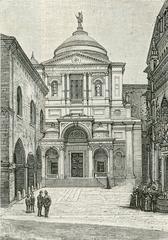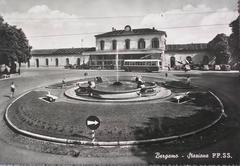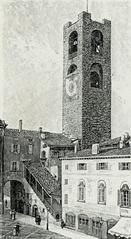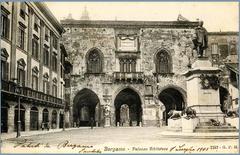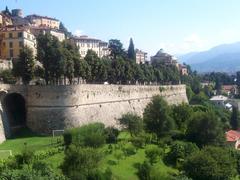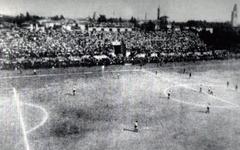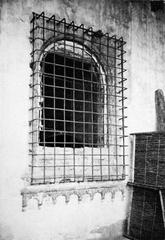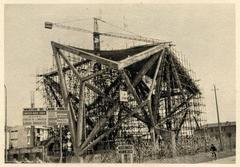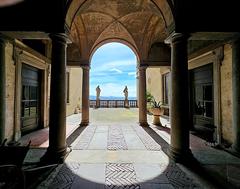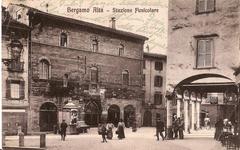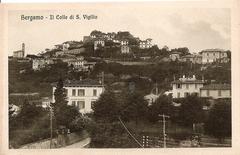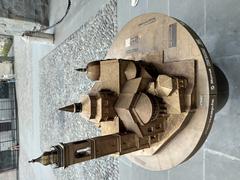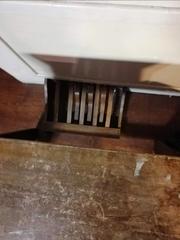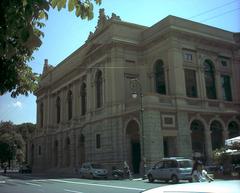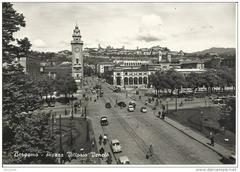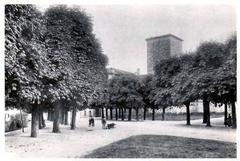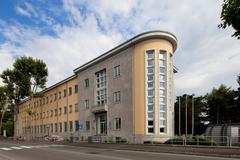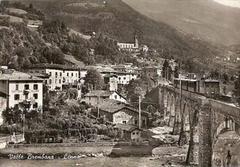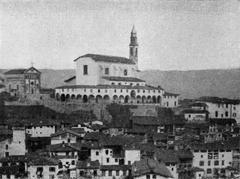
Bergamo–Trescore–Sarnico Tramway: Visiting Hours, Tickets, and Travel Guide
Date: 04/07/2025
Introduction
The Bergamo–Trescore–Sarnico Tramway is a storied symbol of Lombardy’s industrial and cultural evolution. First inaugurated in 1902, this tramway once linked Bergamo’s vibrant city core with Trescore Balneario’s spa culture and Sarnico’s scenic lakeside, acting as a conduit for economic growth, community integration, and the modernization of the region. Though the tramway ceased operations in 1957, its legacy endures—now inviting visitors to explore its repurposed routes, historical landmarks, and the cultural fabric it helped weave.
This comprehensive guide explores the tramway’s history and ongoing influence, while offering practical visitor information: hours, tickets, accessibility, and tips for making the most of your journey. Whether you are a history buff, a culture seeker, or an outdoor adventurer, you will find inspiration and guidance here for tracing the tramway’s enduring path through Lombardy’s landscapes and towns.
Contents
- Introduction
- Historical Context and Development
- Economic and Social Significance
- Urban Transformation and Technological Innovation
- Cultural Heritage and Memory
- Visitor Information: Hours, Tickets, Accessibility
- Visitor Experience and Tips
- Architectural and Engineering Highlights
- Frequently Asked Questions (FAQ)
- Conclusion and Next Steps
Historical Context and Development
The Bergamo–Trescore–Sarnico Tramway arose during a period of rapid modernization in Lombardy. Following Austrian rule, Bergamo’s lower city (Città Bassa) flourished, prompting the need for new transportation links. The tramway opened in 1902 to Trescore Balneario, extended to Sarnico in 1907, and later to Lovere, knitting together a growing economic region (Bergamo historical sites).
Operated by the Società Anonima Funicolare e Tramvia (SAFT), the tramway quickly became vital for trade, tourism, and urban mobility. It was a bold investment in public infrastructure, reflecting the era’s belief in modern transit as a force for progress.
Economic and Social Significance
The tramway transformed local economies by moving people and goods efficiently between Bergamo and the productive valleys. It supported thriving textile industries and opened spa towns like San Pellegrino and Trescore Balneario to broader audiences (Bergamo historical sites). By 1910, the network spanned over 40 kilometers, serving more than a million passengers annually.
Crucially, it also fostered social inclusion, connecting working-class neighborhoods and enabling daily commutes for factory workers, thereby shaping the region’s demographic and economic landscape.
Urban Transformation and Technological Innovation
The tramway mirrored Bergamo’s urban evolution, adapting routes as the city’s center shifted and suburbs expanded. In the 1930s, tracks were rerouted to alleviate congestion and to complement new developments along Via Camozzi and Via Tiraboschi, just outside the ancient walls.
Technologically, the tramway transitioned from steam to electric traction, keeping pace with European urban transit trends. After WWII, neglect and changing transportation needs led to its replacement by trolleybuses and eventually buses, with the final tram journey in 1957 (Bergamo historical sites).
Cultural Heritage and Memory
The tramway’s influence persists in the region’s identity. Repurposed stations, such as the “Al Tram” restaurant in Sarnico, preserve the memory of rail travel while offering regional cuisine in a historic setting (Ristorante al Tram). Many former routes are now main roads or scenic paths, and local museums keep the tramway’s story alive through artifacts and exhibits.
These sites are more than historical curiosities—they are living spaces where locals and visitors connect with the past and enjoy the present.
Visitor Information: Hours, Tickets, and Accessibility
Key Sites and Hours
- Al Tram Restaurant (Sarnico): Open daily, 12:00 PM – 10:00 PM. Check the restaurant’s page for updates.
- Museums (Bergamo, Sarnico, Trescore Balneario): Typically open 9:00 AM – 6:00 PM; hours may vary by season and location.
- Outdoor Paths: Walking and cycling routes along the former tramway are accessible year-round, generally from dawn to dusk.
Tickets and Tours
- Tramway: No operational tram rides; no tickets required.
- Museums: Entry €3–€7, purchase on site.
- Buses: Modern Arriva Italia buses cover the tramway’s historical route; tickets under €5, available at stations, on board, or via mobile app (Arriva Italia).
- Guided Tours: Occasional themed tours available, especially during festivals or via platforms like Audiala.
Accessibility
- Key sites, restaurants, and most museums are wheelchair accessible.
- Outdoor paths vary in surface and gradient—check local tourism offices for details.
- Public transport is accessible and integrated with regional networks (Bergamo Trasporti).
Visitor Experience and Practical Tips
- Start in Bergamo: Explore the Città Alta, Venetian Walls, and the former tramway starting point, marked with plaques (Visit Bergamo).
- Trescore Balneario: Enjoy spa facilities (by appointment), museum exhibits, and walking/cycling paths tracing the tramway.
- Sarnico: Stroll the Lungolago, admire Art Nouveau villas, and enjoy lakefront dining and seasonal festivals (Italy This Way).
- Cycling: Bike rentals are available in Bergamo and Sarnico; portions of the route are now dedicated paths.
- Best Visiting Times: Spring and autumn offer mild weather and fewer crowds; summer is ideal for lake activities.
- Dining: Sample Lombard cuisine at local trattorias and at the “Al Tram” in Sarnico.
Architectural and Engineering Highlights
Stations along the tramway line served multiple purposes—ticketing, social gathering, and local commerce. The route’s engineering overcame hilly terrain with carefully graded tracks and bridges, integrating function and aesthetics. Today, their legacy can be seen in the harmonious blend of infrastructure and landscape along former tramway corridors.
Frequently Asked Questions (FAQ)
Q: Is the tramway still operational?
A: No, the last tram ran in 1957. The route can be explored via modern buses, walking, or cycling paths.
Q: Are tickets required for the tramway route?
A: No tram tickets are needed. Museum and bus tickets are available at each site.
Q: Are there regular guided tours?
A: Not regularly, but special events and tours are offered seasonally or via Audiala.
Q: Is the route accessible for people with disabilities?
A: Most key sites and public transport are accessible, but some outdoor paths may be uneven.
Q: Can I cycle the tramway route?
A: Yes, several sections are now dedicated cycling paths, especially near Trescore Balneario and Sarnico.
Conclusion and Next Steps
The Bergamo–Trescore–Sarnico Tramway is a living testament to Lombardy’s dynamic history and community spirit. Today’s visitors can immerse themselves in this heritage by exploring preserved stations, walking or cycling the scenic routes, dining in historic surroundings, and participating in local cultural events.
To plan your visit:
- Check bus schedules and accessibility at Bergamo Trasporti.
- Book tours or themed experiences via Audiala.
- Explore more on Visit Bergamo for up-to-date events and travel tips.
Embrace the unique blend of history, culture, and natural beauty that the former tramway corridor offers—Lombardy’s past and present await your discovery.
Internal Links
External Links
- Bergamo historical sites
- Ristorante al Tram
- Audiala
- Bergamo Trasporti
- Visit Bergamo
- Arriva Italia
- Italy This Way
- Hikers Bay
Image suggestions:
- Historic photo: “Historic Bergamo–Trescore–Sarnico tramway in early 20th century”
- Current: “Al Tram restaurant in former Sarnico tram station”
- Map: “Map of Bergamo–Trescore–Sarnico tramway route”
- Cycling path: “Walking and cycling paths on the historic tramway route”
- Sarnico waterfront: “Art Nouveau villas along Sarnico’s Lungolago waterfront”
For additional details and planning tools, visit the official websites and consider downloading mobile transit and tourism apps.



